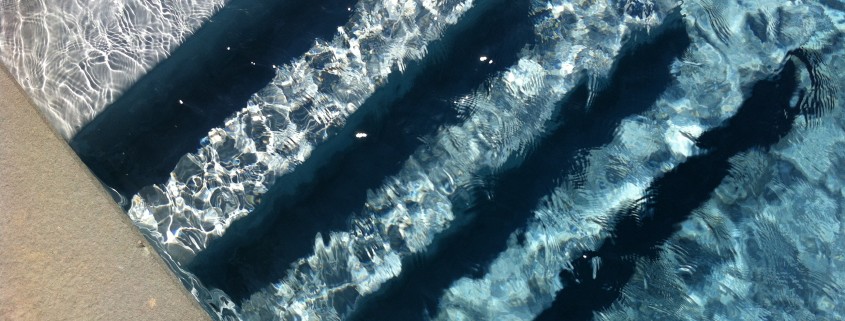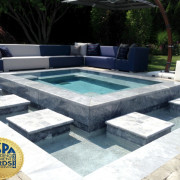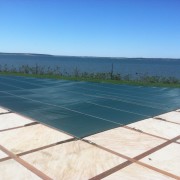The key to a crystal clear pool….
Before reading this please allow me to qualify myself. Personally, I have performed over 10,000 pool cleanings and currently I oversee a company that has performed over 60,000 pool cleanings. Along with thousands of hours of real life experience on the topic, I have also taken many chemistry courses to further understand what is happening within pool water. Although basic pool cleaning and chemistry can be learned within a few days and performed at a relatively decent level, there is a very big difference between pool water maintained by a novice and by a veteran pool cleaner with a good understanding of everything involved in keeping a pool sparkling. For example, I cleaned pools for many years and my last four years cleaning pools I don’t believe one of the pools I maintained had even a one square inch area of algae, ever. This is in stark contrast to the pool industry misconception that once in a while “algae blooms just happen”. Cloudy water, water borne algae, algae that grows on pool surfaces, water that has a chlorine odor, water that burns your eyes, staining on pool surfaces, these are all problems that can be avoided. They don’t just “happen”. There is chemistry behind everything happening in your pool water.
Interested in our pool maintenance? Patrick’s Pools pool maintenance
1. I believe the singular most important and also most overlooked part of keeping a pool crystal clear during the summer months is actually what happens to that water during the 6 months it is not in use. Late fall, Winter, and early Spring is a time when your pool is covered, out of sight and out of mind. Unfortunately this is also the time when your pool water is possibly being tainted permanently. Any time leaves and debris are sitting in your pool water they are destroying the quality of the water essentially forever, or for at least its lifetime within your swimming pool. Leaves sitting in your pool water or on top of a pool cover that drains through to the pool water beneath are releasing ammonia into the water. This ammonia then goes through a biological process called the nitrogen cycle which is as follows:
Ammonia > Nitrite > Nitrate (Do you remember this from 7th grade? Probably not.)
The water is now full of bacteria and nitrogen. Once the water is chlorinated the bacteria will quickly die off but what is left behind forever is water high in nitrogen. There is no such thing as a pool filter that will filter out nitrogen. This water will now be fertile and primed for algae outbreaks for the rest of the time it stays in the pool. This could be a 10 year period. Keep in mind algae is millions of plants, actually more like weeds, since in our pools they are not welcome but can keep “popping” up. The situation that has been created in your pool is similar to adding Miracle Grow to a plant’s soil. Pools with high nitrogen levels may have algae outbreaks even while chlorine levels are within normal ranges or sometimes in bad cases, even with chlorine levels in very high ranges. This is the number one reason for the pool industry misconception that algae “just happens” even with all of the chemicals within range. Actually it didn’t just happen, there was an avoidable reason behind it.
The more leaves and debris sitting in your pool, or draining into your pool, the worse the quality of your pool water forever going forward. Very few people understand this concept and it is a lot to explain to a customer who wants their pool serviced every other week or does not want their pool drained during the winter months and their loop loc cover cleaned of any leaves and debris sitting on top.
The moral of this story:
In order to have high quality sparkling water without using tons of chemicals the actual water quality must be kept high and total dissolved solids kept low. What it takes to make this happen is a minimum of weekly pool cleaning for the entire time the cover is off of the pool. During winter months the pool water must be pumped out and kept well below the bottom of the loop loc cover. No leaves may be allowed to sit on top of the pool cover.
2. Pool water chemistry.
This is an obvious key to a crystal clear pool but the reality is that pool water chemistry is not properly maintained 99.9% of the time. The American National Standards Institute (ANSI) which is the accepted standards maker for swimming pools in the US, calls for public pool water to be tested and adjusted as needed every 3 hours. This is really what it takes for pool water to be maintained properly. Along with the 3 hour rule, there are 10 different chemical levels that I can think of that could be adjusted weekly to perfectly balance pool water, and I have probably missed a few at that. The reality is no one would ever pay to have their pool water tested every third hour, nor would people pay to have ten chemical levels tested and adjusted, not even weekly. It is simply too much.
So as a pool industry professional I have been left with the task of choosing what chemicals I should be using in the swimming pools that my company maintains, all while knowing I’m doing an OK job, but its not really the right job. Its only the best job I can do while charging a rate that people will be willing to pay for. I am not thrilled with this idea but it is an industry standard that I simply have to deal with.
The levels that I believe are most important are:
Chlorine, Ph, Alkalinity, Cyanuric acid, Calcium, Salt, and heavy metals.
If you have all of these levels within range and high water quality, meaning low total dissolved solids and low nitrogen, you will have sparkling water as clear as glass with no chlorine smell or eye irritation. You will also have pool equipment and surfaces that will last. You will have zero chance of any type of algae growing in the pool.
I could explain to you in depth the significance of each of these levels but to a normal person it doesn’t really matter. I will just do a brief explanation of why each level is important.
Chlorine is used as a mild poison to keep our pools clean and clear. In low doses its strong enough to kill any bacteria or plant life (algae), but mild enough that it has little to no effect on people. In fact California water authorities allow for up to a 4 parts per million chlorine level in drinking water, which is more than enough chlorine to keep a pool sparkling. Here is in New York an acceptable chlorine level in your drinking water is 2 ppm which is still enough to keep a pool sparkling. Water authorities use chlorine to sanitize the water you drink and shower with everyday. Chloride is the second most abundant ion in our ocean water.
PH is short for potential of hydrogen. Here in New York the PH level of your pool has a tendency to drop over time for two main reasons. The PH of our rain water is quite acidic, I believe caused by the pollution produced by NYC and New Jersey industries. This acidic rain water lowers our pool water PH levels each time it rains. In different parts of the country there is an opposite effect. The second major reason for the downward PH tendency of our pools is the Cyanuric acid used as a stabilizer within the typical “hockey puck” chlorine tablets that are so common. PH if left unchecked here in NY will spiral down to levels low enough to destroy all pool surfaces and anything metal that touches the pool water. The first things to be destroyed will be marbledust finishes and pool heaters, which are not cheap items. A low PH level will cause pool surface erosion, pools to leak, and will cause burning eyes.
Alkalinity is a PH stabilizer. It raises PH slightly and does not allow PH levels to quickly rise and fall. Its also is commonly known as Sodium Bicarbonate which along with being a pool chemical doubles as Baking Soda for our food, laundry, and teeth. It also acts as a medication to raise the ph levels of our stomachs to prevent ulcers and heartburn. This is the most important chemical in my eyes. I’d rather low chlorine and a pool that turns green over low alkalinity and a pool that self destructs any day of the week. PH and alkalinity are the most overlooked chemicals by uneducated pool cleaners and homeowners. You can keep a pool clear without these, but the pool will have severe long term damage.
Cyanuric acid is used as a chlorine stabilizer. It allows the chlorine to stay in your pool water long term and not just dissipate within a few hours. A cyanuric acid level that is too low will cause your chlorine level to drop rapidly. It will also require you to use a large quantity of chlorine to keep the chlorine levels high enough for a full week. A high level of cyanuric acid will cause your chlorine to be too stable and ineffective. With a very high level of cyanuric acid it is possible to have a chlorine level of 5 times the needed amount and still have a pool filled with algae. “Hockey” puck chlorine tablets contain cyanuric acid in them. Each week when the chlorine tablets are added the cyanuric acid level climbs. This is a chemical level that does not fall on its own. Since this level continues to climb weekly with a pool that uses chlorine tablets, often in August uneducated pool cleaners will run into many algae blooms and not know the cause. They believe that the algae has become immune to the chlorine since their chlorine counts are at the correct level. The problem really is that the cyanuric acid level is high which has made the chlorine less effective.
Calcium is an alkaline earth metal that is especially important in gunite pool water. In much the same way low calcium levels in human beings causes osteoporosis and erosion of bones, low calcium in gunite pool water will cause erosion of marbledust finishes. Pool water seeks to have a calcium level of 200-400 ppm. If it has a level lower than this it will take the calcium from anything that it touches that actually contains calcium within it. This includes all concretes and stone. A low calcium level in a pool with a marbledust finish will have disastrous results.
Salt levels in saltwater chlorine generated pools need to be kept between approximately 2800-3800 parts per million, depending upon the brand of generator. The generator charges the pool water within the salt cell splitting the NaCl ions into Na (sodium) and Cl (chlorine). This result is an unstabilized chlorine which is undetectable by human taste or smell, and the resulting water causes no irritation to human skin or eyes.
Heavy metals that typically cause problems in pools on Long Island are iron and manganese. Certain areas on Long Island have especially high iron levels and homeowners can not use their tap water to fill their pools without a pre-fill filter. Quogue, parts of Hampton Bays and Southampton have the highest amount of iron in their tap water that I know of. High iron levels cause brown stains and brown or off-green water. Copper, which is often used as an ingredient in algaecides can also cause blue water and green/blueish to black staining but the resulting stains are much less offensive than iron staining. Heavy metals can be filtered out or sequestered by a number of metal removing chemicals.
3. Using a pool brush is very important to maintaining an algae free pool. Wall borne algae is much more resilient to algaecides and chlorine than water borne algae. Simply adding chemicals and not brushing algae off of pool walls will not kill the algae.
By Patricks Pools
Sales@patrickspools.com




